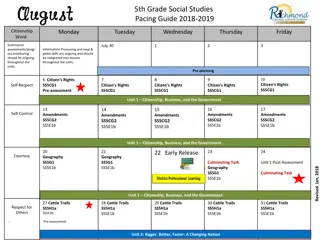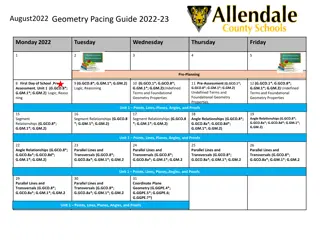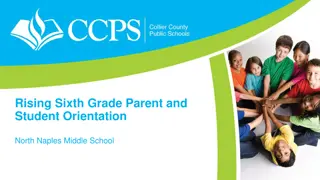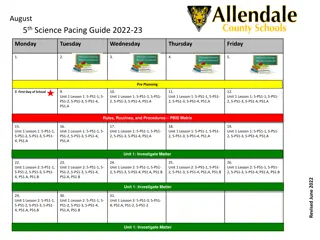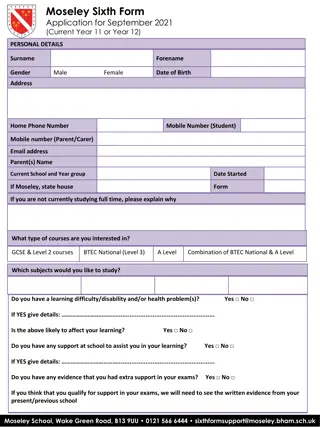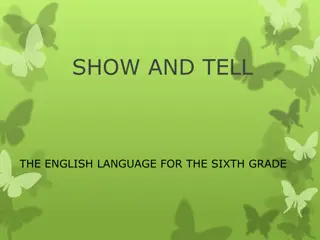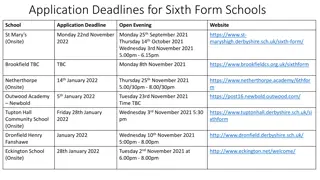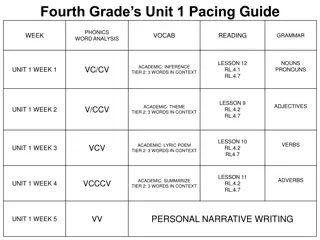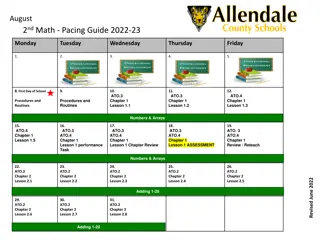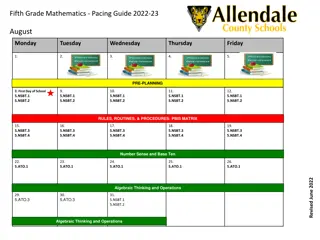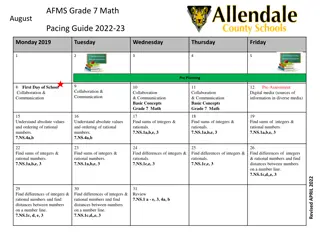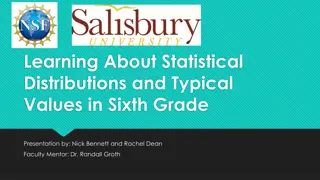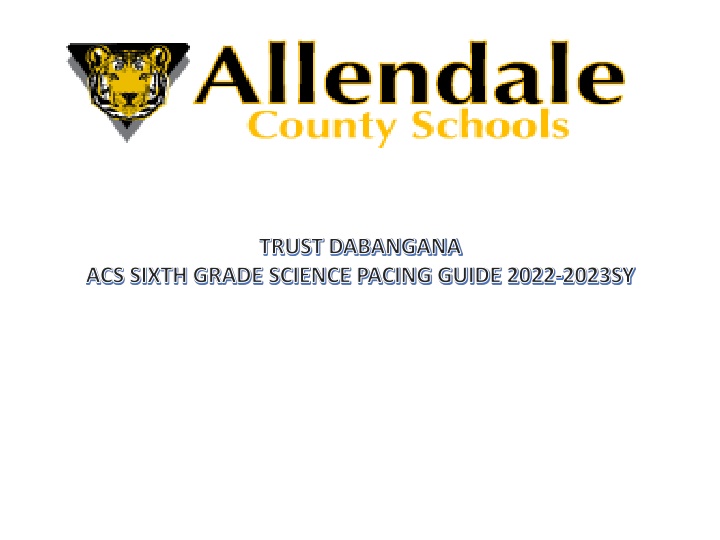
Sixth Grade Science Pacing Guide 2022-2023
This Sixth Grade Science Pacing Guide for the 2022-2023 school year covers topics such as Earth's atmosphere, cycling of water through Earth's systems, weather events, and movement of air masses. The guide provides detailed standards, models, scientific arguments, and activities to engage students in understanding key scientific concepts.
Download Presentation

Please find below an Image/Link to download the presentation.
The content on the website is provided AS IS for your information and personal use only. It may not be sold, licensed, or shared on other websites without obtaining consent from the author. If you encounter any issues during the download, it is possible that the publisher has removed the file from their server.
You are allowed to download the files provided on this website for personal or commercial use, subject to the condition that they are used lawfully. All files are the property of their respective owners.
The content on the website is provided AS IS for your information and personal use only. It may not be sold, licensed, or shared on other websites without obtaining consent from the author.
E N D
Presentation Transcript
TRUST DABANGANA ACS SIXTH GRADE SCIENCE PACING GUIDE 2022-2023SY
August Pacing Guide 2022-23 Monday 2019 Tuesday Wednesday Thursday Friday 1 2 3 4 5 Pre-Planning 9 Pose questions and respond with elaboration Classroom expectations. Relational activity. School handbook 10 PRE-ASSESSMENT EARTH S ATMOSPHERE STANDARD: 6.E.2A.1 (6.S.1A.2, 6.S.1A.4, 6.1A.6) Include standards to be assessed using mastery connect 11 STANDARD: 6.E.2A.1 (6.S.1A.2, 6.S.1A.4, 6.1A.6) Earth s atmosphere: Models and scientific arguments 12 STANDARD: 6.E.2A.1 (6.S.1A.2, 6.S.1A.4, 6.1A.6) Earth s atmosphere: Models and scientific arguments 8 First Day of School Engage in discussion and set goals, classroom expectations/ protocols 15 STANDARD: 6.E.2A.1 (6.S.1A.2, 6.S.1A.4, 6.1A.6) Earth s atmosphere: Models and scientific arguments 16 STANDARD: 6.E.2A.1 (6.S.1A.2, 6.S.1A.4, 6.1A.6) Earth s atmosphere: Models and scientific arguments 17 STANDARD: 6.E.2A.1 (6.S.1A.2, 6.S.1A.4, 6.1A.6) Earth s atmosphere: Models and scientific arguments 18 STANDARD: 6.E.2A.1 (6.S.1A.2, 6.S.1A.4, 6.1A.6) Earth s atmosphere: Models and scientific arguments 19 STANDARD: 6.E.2A.1 (6.S.1A.2, 6.S.1A.4, 6.1A.6) Earth s atmosphere: Models and scientific arguments 22 POST-ASSESSMENT STANDARD: 6.E.2A.1 (6.S.1A.2, 6.S.1A.4, 6.1A.6) Include standards that were assessed. 23 STANDARD: 6.E.2A.2 (6.S.1A.2, 6.S.1A.4, 6.S.1A.6) How different phenomena contribute to earth s atmosphere. 24 STANDARD: 6.E.2A.2 (6.S.1A.2, 6.S.1A.4, 6.S.1A.6) How different phenomena contribute to earth s atmosphere. 25 STANDARD: 6.E.2A.2 (6.S.1A.2, 6.S.1A.4, 6.S.1A.6) How different phenomena contribute to earth s atmosphere. 26 STANDARD: 6.E.2A.2 (6.S.1A.2, 6.S.1A.4, 6.S.1A.6) How different phenomena contribute to earth s atmosphere. Revised APRIL 2022 29 STANDARD: 6.E.2A.3 (6.S.1A.2, 6.S.1A.4, 6.S.1A.6) Cycling of water through earth s systems: models and communicate ideas to others 30 STANDARD: 6.E.2A.3 (6.S.1A.2, 6.S.1A.4, 6.S.1A.6) Cycling of water through earth s systems: models and communicate ideas to others 31 STANDARD: 6.E.2A.3 (6.S.1A.2, 6.S.1A.4, 6.S.1A.6) Cycling of water through earth s systems: models and communicate ideas to others
September Pacing Guide 2022-23 Monday 2019 Tuesday Wednesday Thursday Friday 1 STANDARD: 6.E.2A.3 (6.S.1A.2, 6.S.1A.4, 6.S.1A.6) Cycling of water through earth s systems: models and communicate ideas to others 2 STANDARD: 6.E.2A.3 (6.S.1A.2, 6.S.1A.4, 6.S.1A.6) Cycling of water through earth s systems: models and communicate ideas to others 5 6 STANDARD: 6.E.2B.1 (6.S.1A.2, 6.S.1A.4) Weather event data: Models to represent phenomena and interpret data to support hypothesis, explanations and designs 7 STANDARD: 6.E.2B.1 (6.S.1A.2, 6.S.1A.4) Weather event data: Models to represent phenomena and interpret data to support hypothesis, explanations and designs 8 STANDARD: 6.E.2B.1 (6.S.1A.2, 6.S.1A.4) Weather event data: Models to represent phenomena and interpret data to support hypothesis, explanations and designs 9 FORMATIVE ASSESSMENT STANDARD: 6.E.2B.1 (6.S.1A.2, 6.S.1A.4) Weather event data: Models to represent phenomena and interpret data to support hypothesis, explanations and designs Labor Day Holiday 12 STANDARD: 6.E.2B.2 (6.S.1A.2, 6.S.1A.4) Movement of air masses: Models to represent phenomena and interpret data to support hypothesis, explanations and designs 13 STANDARD: 6.E.2B.2 (6.S.1A.2, 6.S.1A.4) Movement of air masses: Models to represent phenomena and interpret data to support hypothesis, explanations and designs 16 FORMATIVE ASSESSMENT STANDARD: 6.E.2B.2 (6.S.1A.2, 6.S.1A.4) Movement of air masses: Models to represent phenomena and interpret data to support hypothesis, explanations and designs 14 STANDARD: 6.E.2B.2 (6.S.1A.2, 6.S.1A.4) Movement of air masses: Models to represent phenomena and interpret data to support hypothesis, explanations and designs 15 STANDARD: 6.E.2B.2 (6.S.1A.2, 6.S.1A.4) Movement of air masses: Models to represent phenomena and interpret data to support hypothesis, explanations and designs 20 STANDARD: 6.E.2B.3 (6.S.1A.2, 6.S.1A, 4) How solar energy and convection currents impacts weather platforms.: Explanations and designs 19 STANDARD: 6.E.2B.3 (6.S.1A.2, 6.S.1A, 4) How solar energy and convection currents impacts weather platforms.: Explanations and designs 21 STANDARD: 6.E.2B.3 (6.S.1A.2, 6.S.1A, 4) How solar energy and convection currents impacts weather platforms.: Explanations and designs 22 STANDARD: 6.E.2B.3 (6.S.1A.2, 6.S.1A, 4) How solar energy and convection currents impacts weather platforms.: Explanations and designs 23 FORMATIVE ASSESSMENT STANDARD: 6.E.2B.3 (6.S.1A.2, 6.S.1A, 4) How solar energy and convection currents impacts weather platforms.: Explanations and designs Revised APRIL 2022 26 STANDARD: 6.E.2B.4 (6.S.1A.6) How climate is determined: Construct explanations using data, diagram and tables. 27 STANDARD: 6.E.2B.4 (6.S.1A.6) How climate is determined: Construct explanations using data, diagram and tables. 28 STANDARD: 6.E.2B.4 (6.S.1A.6) How climate is determined: Construct explanations using data, diagram and tables. 29 STANDARD: 6.E.2B.4 (6.S.1A.6) How climate is determined: Construct explanations using data, diagram and tables. 30 SUMMATIVE ASSESSMENT STANDARD: 6.E.2B.4 (6.S.1A.6) How climate is determined: Construct explanations using data, diagram and tables.
Pacing Guide 2022-23 October Monday Tuesday Wednesday Thursday Friday 3 STANDARD: 6.P.3A.1. (6.S.1A.2) Compare different forms of energy: Develop, use and refine models to represent phenomena 4 STANDARD: 6.P.3A.1 (6.S.1A.2) Compare different forms of energy: Develop, use and refine models to represent phenomena 5 STANDARD: 6.P.3A.1. (6.S.1A.2) Compare different forms of energy: Develop, use and refine models to represent phenomena 6 STANDARD: 6.P.3A.1. (6.S.1A.2) Compare different forms of energy: Develop, use and refine models to represent phenomena 7 STANDARD: 6.P.3A.1 (6.S.1A.2) Compare different forms of energy: Develop, use and refine models to represent phenomena 11 1ST 9-WEEKS ENDS STANDARD: 6.P.3A.2 (6.S.1A.4) Law of conservation of energy/energy conversions: Analyze and interpret data from tables to construct meanings and patterns. 10 SUMMATIVE ASSESSMENT STANDARD: 6.P.3A.1. (6.S.1A.2) Compare different forms of energy: Develop, use and refine models to represent phenomena 12 13 14 STUDENT AND STAFF HOLIDAY- NO SCHOOL 17 STANDARD: 6.P.3A.2. (6.S.1A.4) Law of conservation of energy/energy conversions: Analyze and interpret data from tables to construct meanings and patterns. 20 EARLY RELEASE DAY STANDARD: 6.P.3A.2 (6.S.1A.4) Law of conservation of energy/energy conversions: Analyze and interpret data from tables to construct meanings and patterns. 18 STANDARD: 6.P.3A.2. (6.S.1A.4) Law of conservation of energy/energy conversions: Analyze and interpret data from tables to construct meanings and patterns. 19 STANDARD: 6.P.3A.2. (6.S.1A.4) Law of conservation of energy/energy conversions: Analyze and interpret data from tables to construct meanings and patterns. 21 PARENT T-C 2:15-5:15 TEACHER WORKDAY 24 STANDARD: 6.P.3A.3. (6.S.1A.6) Electrical circuits, including series and parallel: Construct explanations using of phenomenon using scientific evidence. 25 STANDARD: 6.P.3A.3. (6.S.1A.6) Electrical circuits, including series and parallel: Construct explanations using of phenomenon using scientific evidence. 26 STANDARD: 6.P.3A.3. (6.S.1A.6) Electrical circuits, including series and parallel: Construct explanations using of phenomenon using scientific evidence. 27 STANDARD: 6.P.3A.3. (6.S.1A.6) Electrical circuits, including series and parallel: Construct explanations using of phenomenon using scientific evidence. 28 STANDARD: 6.P.3A.3. (6.S.1A.6) Electrical circuits, including series and parallel: Construct explanations using of phenomenon using scientific evidence. Revised APRIL 2022 30 STANDARD: 6.P.3A.4 (6.S.1A.2) Electrical energy produces magnetic fields we can use: Use models to represent phenomenon 31 STANDARD: 6.P.3A.4 (6.S.1A.2) Electrical energy produces magnetic fields we can use: Use models to represent phenomenon
November Pacing Guide 2022-23 Monday Tuesday Wednesday Thursday Friday 1 STANDARD: 6.P.3A.4 (6.S.1A.2) Electrical energy produces magnetic fields we can use: Use models to represent phenomenon 2 STANDARD: 6.P.3A.4 (6.S.1A.2) Electrical energy produces magnetic fields we can use: Use models to represent phenomenon 3 STANDARD: 6.P.3A.5. (6.S.1A.2) Transfer of heat convection, conduction, radiation: develop models to understand and represent phenomena 4 STANDARD: 6.P.3A.5. (6.S.1A.2) Transfer of heat convection, conduction, radiation: develop models to understand and represent phenomena 7 STANDARD: 6.P.3A.5. (6.S.1A.2) Transfer of heat convection, conduction, radiation: develop models to understand and represent phenomena 8 9 STANDARD: 6.P.3A.5. (6.S.1A.2) Transfer of heat convection, conduction, radiation: develop models to understand and represent phenomena 10 STANDARD: 6.P.3A.5. (6.S.1A.2) Transfer of heat convection, conduction, radiation: develop models to understand and represent phenomena 11 FORMATIVE ASSESSMENT STANDARD: 6.P.3A.5. (6.S.1A.2) Transfer of heat convection, conduction, radiation: develop models to understand and represent phenomena HOLIDAY 14 STANDARD: 6.P.3A.5. (6.S.1A.2) Transfer of heat convection, conduction, radiation: develop models to understand and represent phenomena 15 STANDARD: 6.P.3A.6 (6.S.1B.1) Make and test ways to minimize the transfer of heat: Design solutions using scientific knowledge to solve specific problems 16 STANDARD: 6.P.3A.6 (6.S.1B.1) Make and test ways to minimize the transfer of heat: Design solutions using scientific knowledge to solve specific problems 18 STANDARD: 6.P.3A.6 (6.S.1B.1) Make and test ways to minimize the transfer of heat: Design solutions using scientific knowledge to solve specific problems 17 STANDARD: 6.P.3A.6 (6.S.1B.1) Make and test ways to minimize the transfer of heat: Design solutions using scientific knowledge to solve specific problems 21 STANDARD: 6.P.3A.6 (6.S.1B.1) Make and test ways to minimize the transfer of heat: Design solutions using scientific knowledge to solve specific problems 23 24 25 22 EARLY RELEASE DAY STANDARD: 6.P.3B.1 (6.S.1A.4) How simple machines helps do work how can we prove this?: analyze and interpret data from investigations to support hypothesis Revised APRIL 2022 Thanksgiving Holiday 28 STANDARD: 6.P.3B.1 (6.S.1A.4) How simple machines helps do work how can we prove this?: analyze and interpret data from investigations to support hypothesis 30 STANDARD: 6.P.3B.1 (6.S.1A.4) How simple machines helps do work how can we prove this?: analyze and interpret data from investigations to support hypothesis 29 STANDARD: 6.P.3B.1 (6.S.1A.4) How simple machines helps do work how can we prove this?: analyze and interpret data from investigations to support hypothesis
December Pacing Guide 2022-23 Monday Tuesday Wednesday Thursday Friday 2 STANDARD: 6.P.3B.2 (6.S.1B.1) How simple machines can be made more efficient?: Design solutions including scientific knowledge to solve problems. 1 STANDARD: 6.P.3B.1 (6.S.1A.4) How simple machines helps do work how can we prove this?: analyze and interpret data from investigations to support hypothesis 5 STANDARD: 6.P.3B.2 (6.S.1B.1) How simple machines can be made more efficient?: Design solutions including scientific knowledge to solve problems. 6 STANDARD: 6.P.3B.2 (6.S.1B.1) How simple machines can be made more efficient?: Design solutions including scientific knowledge to solve problems. 7 STANDARD: 6.P.3B.2 (6.S.1B.1) How simple machines can be made more efficient?: Design solutions including scientific knowledge to solve problems. 8 SUMMATIVE ASSESSMENT STANDARD: 6.P.3B.2 (6.S.1B.1) How simple machines can be made more efficient?: Design solutions including scientific knowledge to solve problems. 9 STANDARD: 6.L.4A.1 (6.S.1A.2) Characteristics of all living things: Develop models to use to understand relationships 12 STANDARD: 6.L.4A.1 (6.S.1A.2) Characteristics of all living things: Develop models to use to understand relationships 13 STANDARD: 6.L.4A.1 (6.S.1A.2) Characteristics of all living things: Develop models to use to understand relationships 14 STANDARD: 6.L.4A.1 (6.S.1A.2) Characteristics of all living things: Develop models to use to understand relationships 15 STANDARD: 6.L.4A.1 (6.S.1A.2) Characteristics of all living things: Develop models to use to understand relationships 16. EARLY RELEASE DAY STANDARD: 6.L.4A.2 (6.S.1A.8) Classification of living things: Develop models to identify and fill gaps in knowledge 19 20 21 22 23 Revised APRIL 2022 Christmas Holiday 26 27 28 29 30 Christmas Holiday
January Pacing Guide 2022-23 Monday 2020 Tuesday Wednesday Thursday Friday 2 3 4 STANDARD: 6.L.4A.2 (6.S.1A.8) Classification of living things: Develop models to identify and fill gaps in knowledge 5 STANDARD: 6.L.4A.2 (6.S.1A.8) Classification of living things: Develop models to identify and fill gaps in knowledge 6 STANDARD: 6.L.4A.2 (6.S.1A.8) Classification of living things: Develop models to identify and fill gaps in knowledge HOLIDAY PROFESSIONAL LEARNING 9 2ND 9-WEEKS ENDS STANDARD: 6.L.4A.2 (6.S.1A.8) Classification of living things: Develop models to identify and fill gaps in knowledge 10 STANDARD: 6.L.4A.2 (6.S.1A.8) Classification of living things: Develop models to identify and fill gaps in knowledge 11 STANDARD: 6.L.4B.1 (6.S.1A.4) Compare and contrast vertebrates and invertebrates: Reveals patterns and construct meanings. 12 STANDARD: 6.L.4B.1 (6.S.1A.4) Compare and contrast vertebrates and invertebrates: Reveals patterns and construct meanings. 13 STANDARD: 6.L.4B.1 (6.S.1A.4) Compare and contrast vertebrates and invertebrates: Reveals patterns and construct meanings. REPORT CARD 16 17 STANDARD: 6.L.4B.1 (6.S.1A.4) Compare and contrast vertebrates and invertebrates: Reveals patterns and construct meanings. 18 STANDARD: 6.L.4B.1 (6.S.1A.4) Compare and contrast vertebrates and invertebrates: Reveals patterns and construct meanings. 19 STANDARD: 6.L.4B.1 (6.S.1A.4) Compare and contrast vertebrates and invertebrates: Reveals patterns and construct meanings. 20 FORMATIVE ASSESSMENT STANDARD: 6.L.4B.1 (6.S.1A.4) Compare and contrast vertebrates and invertebrates: Reveals patterns and construct meanings. MLK Holiday 23 STANDARD: 6.L.4B.2 (6.S.1A.4) Structural adaptations and defense, motion and resource obtainment: Support hypothesis, explanations and designs. 24 STANDARD: 6.L.4B.2 (6.S.1A.4) Structural adaptations and defense, motion and resource obtainment: Support hypothesis, explanations and designs. 25 STANDARD: 6.L.4B.2 (6.S.1A.4) Structural adaptations and defense, motion and resource obtainment: Support hypothesis, explanations and designs. 26 STANDARD: 6.L.4B.2 (6.S.1A.4) Structural adaptations and defense, motion and resource obtainment: Support hypothesis, explanations and designs. 27 STANDARD: 6.L.4B.2 (6.S.1A.4) Structural adaptations and defense, motion and resource obtainment: Support hypothesis, explanations and designs. Revised APRIL 2022 30 STANDARD: 6.L.4B.3 (6.S.1A.6) Animal response that allow for survival and reproduction: Construct explanations of phenomena using scientific evidence and models. 31 FORMATIVE ASSESSMENT STANDARD: 6.L.4B.3 (6.S.1A.6) Animal response that allow for survival and reproduction: Construct explanations of phenomena using scientific evidence and models.
February Pacing Guide 2022-23 Monday Tuesday Wednesday Thursday Friday 1 STANDARD: 6.L.4B.4 (6.S.1A.8) Compare and contrast innate and learned behaviors: Evaluate scientific information to explain or describe the phenomena 2 STANDARD: 6.L.4B.4 (6.S.1A.8) Compare and contrast innate and learned behaviors: Evaluate scientific information to explain or describe the phenomena 3 STANDARD: 6.L.4B.4 (6.S.1A.8) Compare and contrast innate and learned behaviors: Evaluate scientific information to explain or describe the phenomena 6 STANDARD: 6.L.4B.4 (6.S.1A.8) Compare and contrast innate and learned behaviors: Evaluate scientific information to explain or describe the phenomena 7 STANDARD: 6.L.4B.5 (6.S.1A.8) How endothermic and ectothermic animals respond to changes in the environment: Evaluate scientific information to explain phenomena. 8 STANDARD: 6.L.4B.5 (6.S.1A.8) How endothermic and ectothermic animals respond to changes in the environment: Evaluate scientific information to explain phenomena. 9 STANDARD: 6.L.4B.5 (6.S.1A.8) How endothermic and ectothermic animals respond to changes in the environment: Evaluate scientific information to explain phenomena. 10 STANDARD: 6.L.4B.5 (6.S.1A.8) How endothermic and ectothermic animals respond to changes in the environment: Evaluate scientific information to explain phenomena. 13 FORMATIVE ASSESSMENT STANDARD: 6.L.4B.5 (6.S.1A.8) How endothermic and ectothermic animals respond to changes in the environment: Evaluate scientific information to explain phenomena. 15 STANDARD:6.L.5A.1 (6.S.1A.4) How fungi and protist structures allow for the obtainment of resources: Use data to construct meaning or explanations. 16 STANDARD:6.L.5A.1 (6.S.1A.4) How fungi and protist structures allow for the obtainment of resources: Use data to construct meaning or explanations. 17 STANDARD:6.L.5A.1 (6.S.1A.4) How fungi and protist structures allow for the obtainment of resources: Use data to construct meaning or explanations. 14 STANDARD:6.L.5A.1 (6.S.1A.4) How fungi and protist structures allow for the obtainment of resources: Use data to construct meaning or explanations. 20 21 22 23 24 Revised APRIL 2022 STUDENT AND STAFF HOLIDAY NO SCHOOL 27 STANDARD:6.L.5A.1 (6.S.1A.4) How fungi and protist structures allow for the obtainment of resources: Use data to construct meaning or explanations. 28 STANDARD: 6.L.5A.2 (6.S.1A.4) How fungi respond to stimuli: Use data to construct meaning of support hypothesis.
Pacing Guide 2022-23 March Monday Tuesday Wednesday Thursday Friday 1 STANDARD: 6.L.5A.2 (6.S.1A.4) How fungi respond to stimuli: Use data to construct meaning of support hypothesis. 2 STANDARD: 6.L.5A.2 (6.S.1A.4) How fungi respond to stimuli: Use data to construct meaning of support hypothesis. 3 STANDARD: 6.L.5A.2 (6.S.1A.4) How fungi respond to stimuli: Use data to construct meaning of support hypothesis. 6 STANDARD: 6.L.5A.2 (6.S.1A.4) How fungi respond to stimuli: Use data to construct meaning of support hypothesis. 8 STANDARD: 6.L.5B.1 (6.S.1A.2) Compare and Contrast vascular and nonvascular plants: Develop and use models understand processes and phenomena. 7 STANDARD: 6.L.5B.1 (6.S.1A.2) Compare and Contrast vascular and nonvascular plants: Develop and use models understand processes and phenomena. 9 STANDARD: 6.L.5B.1 (6.S.1A.2) Compare and Contrast vascular and nonvascular plants: Develop and use models understand processes and phenomena. 10 STANDARD: 6.L.5B.1 (6.S.1A.2) Compare and Contrast vascular and nonvascular plants: Develop and use models understand processes and phenomena. 13 FORMATIVE ASSESSMENT STANDARD: 6.L.5B.1 (6.S.1A.2) Compare and Contrast vascular and nonvascular plants: Develop and use models understand processes and phenomena. 14 STANDARD: 6.L.5B.2 (6.S.1A.4) How photosynthesis, respiration, and transpiration work together: Use data from investigations to reveal patterns and construct meanings. 15 STANDARD: 6.L.5B.2 (6.S.1A.4) How photosynthesis, respiration, and transpiration work together: Use data from investigations to reveal patterns and construct meanings. 16 STANDARD: 6.L.5B.2 (6.S.1A.4) How photosynthesis, respiration, and transpiration work together: Use data from investigations to reveal patterns and construct meanings. 17 STANDARD: 6.L.5B.2 (6.S.1A.4) How photosynthesis, respiration, and transpiration work together: Use data from investigations to reveal patterns and construct meanings. 22 3RD 9-WEEKS ENDS STANDARD: 6.L.5B.3 (6.S.1A.6) Adaptations of plants for defense, survival and reproduction: Construct explanations using scientific evidence and models 20 STANDARD: 6.L.5B.2 (6.S.1A.4) How photosynthesis, respiration, and transpiration work together: Use data from investigations to reveal patterns and construct meanings. 21 STANDARD: 6.L.5B.3 (6.S.1A.6) Adaptations of plants for defense, survival and reproduction: Construct explanations using scientific evidence and models 23 STANDARD: 6.L.5B.3 (6.S.1A.6) Adaptations of plants for defense, survival and reproduction: Construct explanations using scientific evidence and models 24 STANDARD: 6.L.5B.3 (6.S.1A.6) Adaptations of plants for defense, survival and reproduction: Construct explanations using scientific evidence and models Revised APRIL 2022 28 STANDARD: 6.L.5B.4 (6.S.1A.3) How environmental affect plants: formulate scientific questions and testable hypotheses 29 STANDARD: 6.L.5B.4 (6.S.1A.3) How environmental affect plants: formulate scientific questions and testable hypotheses 30 EARLY RELEASE DAY. 31 27 REPORT CARD STANDARD: 6.L.5B.4 (6.S.1A.3) How environmental affect plants: formulate scientific questions and testable hypotheses SUMMATIVE ASSESSMENT District Professional Learning PARENT T-C 2:15-5:15
April Pacing Guide 2022-23 Monday Tuesday Wednesday Thursday Friday 3 STANDARD: 6.L.5B.4 (6.S.1A.3) How environmental affect plants: formulate scientific questions and testable hypotheses 4 STANDARD: 6.L.5B.5 (6.S.1A.6) How plants respond to external stimuli: Reveal patterns and construct meanings or support hypotheses. 5 STANDARD: 6.L.5B.5 (6.S.1A.6) How plants respond to external stimuli: Reveal patterns and construct meanings or support hypotheses. 6 STANDARD: 6.L.5B.5 (6.S.1A.6) How plants respond to external stimuli: Reveal patterns and construct meanings or support hypotheses. 7 HOLIDAY 10 11 12 13 14 Spring Break 17 SUMMATIVE ASSSESSMENT STANDARD: 6.L.5B.5 (6.S.1A.6) How plants respond to external stimuli: Reveal patterns and construct meanings or support hypotheses. 18 19 20 21 REVIEW REVIEW REVIEW REVIEW 24 25 26 27 28 REVIEW REVIEW REVIEW REVIEW REVIEW Revised APRIL 2022
May Pacing Guide 2022-23 Monday Tuesday Wednesday Thursday Friday 1 2 3 4 5 REVIEW REVIEW REVIEW REVIEW TEACHER WORKDAY 8 9 10 11 12 REVIEW REVIEW REVIEW REVIEW REVIEW 15 STANDARD: 6.ESS1-4 Scientific explanation based on evidence from rock strata for how geologic time scale is used to organize Earth s old history. 16 STANDARD: 6.ESS1-4 Scientific explanation based on evidence from rock strata for how geologic time scale is used to organize Earth s old history. 17 STANDARD: 6.ESS1-4 Scientific explanation based on evidence from rock strata for how geologic time scale is used to organize Earth s old history. 18 STANDARD: 6.ESS1-4 Scientific explanation based on evidence from rock strata for how geologic time scale is used to organize Earth s old history. 19 STANDARD: 6.ESS1-4 Scientific explanation based on evidence from rock strata for how geologic time scale is used to organize Earth s old history. 22 STANDARD: 6.ESS1-4 Scientific explanation based on evidence from rock strata for how geologic time scale is used to organize Earth s old history. 23 STANDARD: 6-ESS1-1 Construct explanation based on evidence for how the geoscience processes have changed Earth s surface at varying time and spatial scales. 24 STANDARD: 6-ESS1-1 Construct explanation based on evidence for how the geoscience processes have changed Earth s surface at varying time and spatial scales. 25 STANDARD: 6-ESS1-1 Construct explanation based on evidence for how the geoscience processes have changed Earth s surface at varying time and spatial scales. 26 STANDARD: 6-ESS1-1 Construct explanation based on evidence for how the geoscience processes have changed Earth s surface at varying time and spatial scales. Revised APRIL 2022 29 30 STANDARD: 6-ESS1-1 Construct explanation based on evidence for how the geoscience processes have changed Earth s surface at varying time and spatial scales. 31 Memorial Day
June Pacing Guide 2022-23 Monday Tuesday Wednesday Thursday Friday 1 STANDARD: 6-ESS1-1 Construct explanation based on evidence for how the geoscience processes have changed Earth s surface at varying time and spatial scales. 2 5 4TH 9-WEEKS ENDS LAST DAY OF SCHOOL 6 REPORT CARD 7 8 9 TEACHER WORKDAY 12 13 14 15 16 19 20 21 22 23 Revised APRIL 2022 26 27 28 29 30





